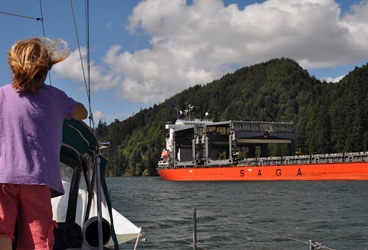
Del Viento- Columbia River
NEAH BAY, WA
Seven-hundred miles north of San Francisco, Windy motored us out of the port of Ilwaco, Washington (just inside the mouth of the Columbia River). I looked up when she began calling out the depths as they descended, “Nine-point-two…eight-point-seven…eight…seven-point-four…six-point…whoa!” We all lurched forward as Del Viento came to a stop.
I’m embarrassed to write that I was stunned. We hit bottom? Windy could have called out two-hundred feet and I would have been no less surprised that we were sitting on the bottom. I mean, I’ve read about this running aground thing, but the idea of it seemed abstract. We sailed from Puerto Vallarta to San Francisco without a working depth sounder and never had a problem. Now we had new instruments and here we rested on the bottom in a marked channel.
Thoughtfully, I reminded Windy and the girls aloud of something else I’ve read: “Well, if you haven’t been aground, you haven’t been around.” Smiling, I turned to Windy and added, “I’m so glad you ran us aground and not me.”
I took the helm and tried to motor us off: reverse—forward—reverse. Nothing. We waved gamely at fishermen as they went by in a deeper part of the channel. Stuck? Nope, we were resting on the sand bar, exactly what we aimed to be doing. I hoped we weren’t still there when they returned.
My mind pulled up things I’d read over the years about boats aground. “I think you and the girls should sit on the end of the boom and I’ll swing it out. That’ll induce a heel and reduce our draft.”
Windy looked around and then up at me, “No. Why don’t we row an anchor out and kedge ourselves off?”
“Yeah, I’ve read that too. But let’s get a sail up first and see if that helps.” I unfurled the head sail, we were on a close reach. Del Viento heeled a bit and moved forward slightly into shallower water. I furled the sail.
“Okay,” I said, “I’m gonna try the engine again, I have an idea.” I powered forward, turning our big, well-protected rudder from one side to the other. I imagined our keel twisting back and forth, carving a hole in the bottom. It soon seemed to make a difference and our swing radius continued to increase. As we gained more motion, I added reverse to the repertoire. Ten minutes after running aground, we were free, once again heading 10 miles up the Columbia River on our way to Astoria, Oregon.
Ten days later, after motoring the entire 110 miles up-river and inland to Portland, Oregon and spending a week visiting family and friends, it was time to head back downriver.
On the first day of our return trip, our friends Amy Jo and Paul and their son Ossley joined us aboard. The weather was beautiful and we had a favorable current. I was at the helm, I was navigating, and I was tongue-in-cheek regaling Amy Jo and Paul with the story of Windy running us aground.
(You see where I’m going with this?)
We were going fast, with the river pushing us, our speed over ground was about 8 knots. I happened to notice the depth sounder read about seven feet. Huh? I was trying to process this information when we ground to a halt. It was like setting a plow anchor, digging in deep to something soft. When we stopped, we were in good, there was no motion—Del Viento felt like she did when she was hauled out weeks before, on the hard, high-and-dry, propped up with jack stands.
After several minutes, having tried the same motor dance I’d used to free us in Ilwaco, we were more stuck than ever. This time there was a downriver current on our beam, heeling us over, attempting to push us into shallower water. Looking down, I could see the bottom. We sat around, considering the situation and talking about our options. I asked Amy Jo and Paul if they’d brought their pajamas.
Having consulted the iPad to see where I’d left the channel and where the deeper water was, I returned to the engine technique with renewed vigor. After several more minutes of my asking, “Does anyone see movement yet?” I started getting tentative, and then affirmative responses. We all rejoiced to be on our way again.
Windy pointed out that when she ran us aground, we were motoring cautiously ahead at two knots, in the channel, that it was an unfortunate circumstance, not an error of navigation. I just blamed the depth sounder, “This never happened before we knew how shallow the water was.”
–MR
I__n our twenties, we traded our boat for a house and our freedom for careers. In our thirties, we slumbered through the American dream. In our forties, we woke and traded our house for a boat and our careers for freedom. And here we are. Follow along at http://www.logofdelviento.blogspot.com/







